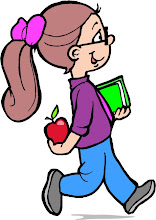We are reading Meet the Men who Sailed the Seas by John Dyment. This is a Step-Up Book. I hadn't planned to use this book for Reading, but the book Meet Christopher Columbus hasn't reached our library yet. Meet the Men starts with "The First Sailors" and so the first seven chapters review things we learned in History in kindergarten and first grade. Then it goes on to Columbus, Magellan, Drake, The Mayflower, Cook, and John Paul Jones -- people and events we will study this year (9 chapters). Each chapter only has three full or five partial pages of text, so one chapter a day works really well. The illustrations are good, but are not full color. The information is presented in an interesting way at K.'s level, with a few of challenging words in each chapter.
To review the Comprehension Skills we worked on last year:
- I've been reading a new short story to K. then asking her some or all of these questions:
- Can you summarize the story with one word?
- What would be a good title for this story?
- What kind of story was this?
- Have you read any other stories that were similar to this one? How were they alike?
- What is the most important sentence in this paragraph?
- One day I showed K. several pictures (one at a time) and had her tell me one word that gave the main idea of the picture.
- I read paragraphs to her and had K. give me the main idea.
- I also found some games on-line that we enjoyed playing: The Hamburger Game and Jeopardy Main Idea Review Game.
- Now K. is working on drawing pictures that tell a story (I had three options and let her pick one). Once it is done I'll put pictures up. The pictures are on a roll of paper and will be attached to dowel rods that will be turned to show one picture at a time through a hole cut in a box. She calls it a TV.
- Category Tic-Tac-Toe: In each space there are three words that belong in the same category (slide, swing, monkey bars). Before putting your "X" or "O" down, each player has to tell the category and add one more item (teeter-totter).
- Read a short story to your child. Then trace around their hand on a piece of paper. Have them write the main idea on the palm and five details on the fingers/thumb.
- Read a short story, or a chapter of a longer story, to your child then take turns making up a telegram about the story.
- Here are a couple more on-line games for practice identifying the main idea and details: What's the Big Idea? and Identify the Main Idea
- We wrote three or four word sentences, then exchanged papers and added more details. The first day we tried to make each into a ten word sentence. The next day we tried to add four or so words that began with the same letter. K. kept just adding words to the end of the sentence, so I started putting blanks in the sentence so she would add description/details. Example: The ___ ___ cow mooed ___ ___. Might become: The big brown cow mooed behind the barn.
- I read a story to K., then asked her if ___ was different would it change the story? The blank could be the color of some one's clothes or where the story took place, etc. Any detail in the story.
- K. finished drawing the pictures for her TV (see above) and told the story to her aunt.
From Games for Reading we did:
- Two Drawing Games, page 42 -- I started with the easy game. I drew a simple design and then K. copied it. That was too easy, so after one round we went on to the next game. I drew a simple picture/design and let K. study it until she thought she knew it. Then I had her turn around and I added ONE thing to the picture. She had to find the change. This game helps children be able to distinguish "pot" from "pet".
- Jigsaw Puzzles, page 30 -- jigsaws are useful for visual perception
- Mazes, page 26 -- mazes are a great eye exercise and are also good for penmanship

No comments:
Post a Comment